Sarah had always been active, but after a minor back strain, she found herself caught in a frustrating cycle. One expert told her she needed to stretch more, while another said she needed to strengthen her core. Confused and still in pain, she wondered: Should I focus on strength or flexibility for a healthy spine?
The truth is, optimal spinal health isn’t about choosing one over the other—it’s about balance. Let’s break down the roles of strength and flexibility in spinal health and how to train for longevity.
Myth #1: More Flexibility Always Equals a Healthier Spine
Fact: Hyper-Mobility Can Be Just as Problematic as Stiffness
Many believe that tight muscles are the enemy and that more flexibility is always better. However, excessive flexibility without strength can lead to instability and injury. A spine that moves too much without adequate control can overstress ligaments and joints, leading to chronic pain.
Research from Parker Seminars highlights that spinal health depends on controlled mobility—the ability to move freely while maintaining stability. Rather than stretching aimlessly, focusing on functional flexibility ensures that movement is both smooth and supported.
Myth #2: Strengthening the Spine Means Doing More Crunches
Fact: True Strength Comes from Stabilization, Not Just Movement
Core strength isn’t about six-pack abs—it’s about how well the deep stabilizing muscles engage to support spinal alignment. The spine relies on a complex system of muscles, including:
-
Intrinsic stabilizers (multifidus, transverse abdominis) that provide deep support
-
Global movers (rectus abdominis, obliques) that generate power
-
Posterior chain muscles (glutes, hamstrings) that influence spinal mechanics
A well-balanced spine training program includes exercises that enhance both strength and coordination rather than just increasing raw power.
Myth #3: Yoga and Stretching Are Enough to Prevent Back Pain
Fact: Strength and Stability Training Are Equally Important
Yoga and stretching routines can be fantastic for improving mobility and calming the nervous system. However, without strength training to reinforce movement patterns, flexibility alone won’t prevent injury.
Studies show that individuals with back pain often have weakened deep core muscles that fail to engage properly, leading to compensations and further pain. By incorporating stability exercises like planks, resisted carries, and spinal stabilization drills, you create a foundation that allows flexibility to be functional rather than excessive.
The Ideal Balance: How to Train Your Spine for Longevity
A well-rounded approach to spinal health includes both strength and flexibility, but in a strategic way. Here’s how to structure your routine:
1. Start with Mobility Work – Dynamic stretches and controlled movements to prepare the spine for activity (e.g., cat-cow, segmental rolling).
2. Build Stability First – Focus on engaging the deep core and posterior chain with exercises like dead bugs, bird dogs, and bridges.
3. Strengthen with Functional Movements – Train the body to move under load while maintaining spinal integrity (e.g., kettlebell carries, squats, and hip hinges).
4. Maintain Flexibility Where It Matters – Stretch tight areas while ensuring you have the strength to support that range of motion.
5. Incorporate Neuromuscular Training – Exercises that improve brain-body connection, such as balance drills and proprioceptive work, enhance movement control and reduce injury risk.
Sarah’s Breakthrough: Finding the Balance
Instead of choosing between flexibility or strength, Sarah adopted a strategy that prioritized stability first, then layered in controlled mobility and functional strength. Within weeks, she noticed improved posture, reduced pain, and confidence in movement she hadn’t felt in years.
For those looking to train their spine for long-term health, the answer isn’t stretching or strengthening—it’s integrating both in a way that supports resilient, pain-free movement. By understanding how your body moves and training accordingly, you can build a spine that lasts a lifetime.
Want to know what kind of back pain you have?
-

Bicep Tendon Pain Solution
$50.00 -

Brain Detoxification & Recovery System
$50.00 -

Brain Energy and Endurance Support System
$50.00 -

Brain-Based Movement and Motor Control Training
$50.00 -

Centralized Low Back Pain
$50.00 -

Cervical Radiculopathy: Neck and Nerve Relief Pathway
$50.00 -

Complex Low Back Pain
$50.00 -

Complex Radiating Low Back Pain
$50.00 -

Cross-Pattern Low Back Pain
$50.00 -

Frozen Shoulder Mobility Reset Plan
$50.00 -

Impingement Syndrome: Shoulder Relief Framework
$50.00 -

Mastering Brain Senses: Rebuild Your Hearing, Vision, and Body Awareness
$50.00













